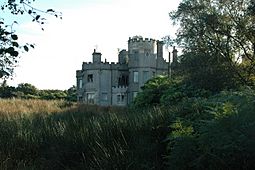Shuna, Slate Islands facts for kids
| Gaelic name | Siùna |
|---|---|
| Meaning of name | Possibly sea island |
 The ruined castle |
|
| OS grid reference | NM760080 |
| Coordinates | 56°13′N 5°37′W / 56.21°N 5.61°W |
| Physical geography | |
| Island group | Slate Islands |
| Area | 451 ha (1,114 acres) |
| Area rank | 74 |
| Highest elevation | Druim na Dubh Ghlaic, 90 m (295 ft) |
| Administration | |
| Sovereign state | United Kingdom |
| Country | Scotland |
| Council area | Argyll and Bute |
| Demographics | |
| Population | 3 |
| Population density | 0.7/km2 (1.8/sq mi) |
Shuna (in Gaelic, Siuna) is a small island off the west coast of Scotland. It is part of the Slate Islands group. Shuna lies to the east of the larger island of Luing.
Contents
A Look at Shuna's Past
Who Owned Shuna Island?
In 1815, a man named James Yates from Glasgow bought Shuna. He lived far away in Devon, England. When he passed away in 1829, he left the island to the city of Glasgow.
His plan was for the money made from the island to be shared. Two-fifths would go to Glasgow City, two-fifths to the University of Glasgow, and one-fifth to the Glasgow Royal Infirmary hospital.
However, Yates's family member who was supposed to inherit his property disagreed with this plan. The city paid him £300 to settle the issue. The island did not make much money, so the city sold it in 1911.
The Story of Shuna Castle
Shuna Castle is not as old as some castles you might imagine. It was built in 1911. The castle was used for many years. But by the 1980s, it became too expensive to keep up. Because of this, the castle slowly fell apart.
Farming and Old Stones on Shuna
Unlike other islands in the Slate Islands group, Shuna does not have much slate. Instead, people used to farm on the island. Today, much of the island is covered in woodland. You can also find several cairns, which are piles of stones, in the south and west parts of the island. These cairns might be very old.
How Many People Live on Shuna?
In the 1800s, many people lived on Shuna, sometimes as many as 69. But by 2001, only one person lived there. The Gully family has owned the island since 1946. In 2011, three people lived on Shuna. They are a farmer and his family. They also rent out four houses on the island for people to stay in on holiday.
Wildlife on Shuna Island
Shuna is home to many different animals. You can find healthy groups of red deer, roe deer, and fallow deer living on the island.
In the waters around Shuna, you might spot other amazing creatures. There are otters, which are playful animals. You can also see common seals and grey seals swimming. Sometimes, porpoises and dolphins visit the waters near the island too.

